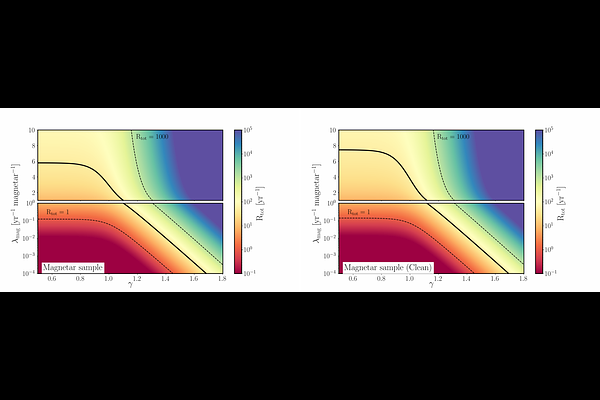The Northern Cross Fast Radio Burst project: V. Search for transient radio emission from Galactic magnetars

The Northern Cross Fast Radio Burst project: V. Search for transient radio emission from Galactic magnetars
A. Geminardi, P. Esposito, G. Bernardi, M. Pilia, D. Pelliciari, G. Naldi, D. Dallacasa, R. Turolla, L. Stella, F. Perini, F. Verrecchia, C. Casentini, M. Trudu, R. Lulli, A. Maccaferri, A. Magro, A. Mattana, G. Bianchi, G. Pupillo, C. Bortolotti, M. Tavani, M. Roma, M. Schiaffino, G. Setti
AbstractContext. The radio emission from magnetars is poorly understood and poorly characterized observationally, in particular for what concerns single pulses and sporadic events. The interest in it was boosted by the detection in 2020 of an extremely bright ms radio signal from the Galactic magnetar designated Soft Gamma Repeater (SGR) SGR J1935+2154, which occurred almost simultaneously with a typical magnetar short burst of X-rays. As of now, this event remains the Galactic radio pulse that is the most reminiscent of fast radio bursts (FRBs) and the only one with a sound association with a known progenitor. Aims. We aim to constrain the rate of impulsive radio events from magnetars, by means of an intensive monitoring using a high-sensitivity radio telescope. Methods. We performed a long-term campaign on seven Galactic magnetars (plus one candidate) using the Northern Cross transit radio telescope (in Medicina, Italy) searching for short timescales and dispersed radio pulses. Results. We obtained no detections in more than 560 hours of observation, setting an upper limit at 95% confidence level of <52 yr$^{-1}$ on the rate of events with energy >10$^{28}$ erg, which is consistent with limits in literature. Furthermore, under some assumptions on the magnetars properties and energetic behavior, we found that our upper limits point towards the fact that the entire population of FRBs observed cannot be explained by radio bursts emitted by magnetars.